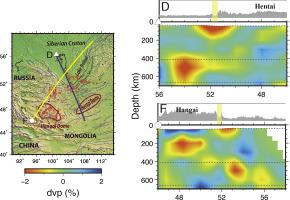当前位置:
X-MOL 学术
›
Phys. Earth Planet. Inter.
›
论文详情
Our official English website, www.x-mol.net, welcomes your feedback! (Note: you will need to create a separate account there.)
Deep structure beneath the southwestern flank of the Baikal rift zone and adjacent areas
Physics of the Earth and Planetary Interiors ( IF 2.3 ) Pub Date : 2021-01-01 , DOI: 10.1016/j.pepi.2020.106616 Hanting Wu , Zhouchuan Huang , Dapeng Zhao
Physics of the Earth and Planetary Interiors ( IF 2.3 ) Pub Date : 2021-01-01 , DOI: 10.1016/j.pepi.2020.106616 Hanting Wu , Zhouchuan Huang , Dapeng Zhao

|
Abstract The origin of the Baikal rift zone is under debate between active and passive rifting hypotheses owning to the enigmatic deep structure beneath the region. Revealing the formation mechanism of the Baikal rift zone may help to elucidate the process of continental rifting. Applying P-wave teleseismic tomography to an improved data set, we discover low-velocity anomalies under the southwestern flank of the Baikal rift zone, which are interpreted as hot mantle upwellings from under the Siberian craton, indicating hot materials transferring from beneath the craton to beneath the rift. Our images also reveal low-velocity anomalies under the Hangai Dome, probably suggesting the process of delamination, another consequent effect connected to the Siberian upwellings. We propose that the mantle upwellings beneath the Baikal rift zone and surrounding areas play a vital role in the formation of deep structures and geological settings in this area.
中文翻译:

贝加尔湖裂谷带西南翼及邻近地区深部构造
摘要 贝加尔湖裂谷带的起源在主动和被动裂谷假说之间争论不休,因为该地区下有神秘的深部构造。揭示贝加尔湖裂谷带的形成机制可能有助于阐明大陆裂谷的过程。将 P 波远震层析成像应用于改进的数据集,我们发现了贝加尔湖裂谷带西南翼下的低速异常,这被解释为来自西伯利亚克拉通下方的热地幔上涌,表明热物质从克拉通下方转移到裂痕之下。我们的图像还揭示了汉盖穹顶下的低速异常现象,这可能暗示了分层过程,这是与西伯利亚上升流相关的另一个后果。
更新日期:2021-01-01
中文翻译:

贝加尔湖裂谷带西南翼及邻近地区深部构造
摘要 贝加尔湖裂谷带的起源在主动和被动裂谷假说之间争论不休,因为该地区下有神秘的深部构造。揭示贝加尔湖裂谷带的形成机制可能有助于阐明大陆裂谷的过程。将 P 波远震层析成像应用于改进的数据集,我们发现了贝加尔湖裂谷带西南翼下的低速异常,这被解释为来自西伯利亚克拉通下方的热地幔上涌,表明热物质从克拉通下方转移到裂痕之下。我们的图像还揭示了汉盖穹顶下的低速异常现象,这可能暗示了分层过程,这是与西伯利亚上升流相关的另一个后果。



























 京公网安备 11010802027423号
京公网安备 11010802027423号